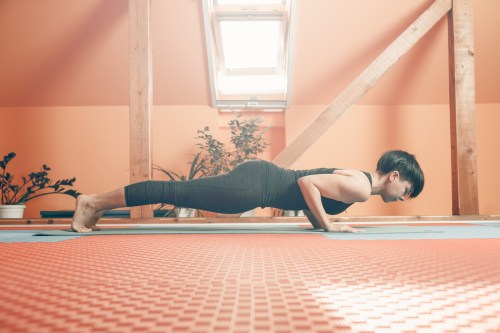Yoga pros see chaturanga done wrong all the time—here’s how to build enough strength to nail it
Yoga pros break down how to work your way up to a perfect chaturanga, plus how to do chaturanga in proper form in your practice.

Typically, the beginning of a yoga flow is relatively simple as you are just starting to stretch your body out before more advanced standing sequences. But in your sun salutations, after a feels-so-good downward dog followed by a plank comes, there comes chaturanga… one of the most sneakily challenging yoga moves around. It’s actually pretty advanced, but yoga instructors are sharing their tips on working your way up to the perfect chaturanga.
“Chaturanga is so challenging because of the strength it takes to do it, and often there’s not a ton of time in a group yoga class to talk through everything you need to know in order to do it properly,” says Jess Penesso, yoga instructor and founder of The Sweat Method, who notes that she sees the move done incorrectly a lot of the time. Known as a yoga push-up, chaturanga is similar to a tricep push-up variation, but requires more stability since you’re hovering above your mat in one straight line with your elbows bent in at 90-degrees (my core is burning just thinking about it).
Doing chaturanga incorrectly can not only detract from the tricep and core workout that you’re getting, but can lead to back pain or even injury. “The most common thing that I see is what I call the swoop,” says Penesso. “This is when you drop your hips as you move through chaturanga to upward facing dog, which disengages the core and is tough on your low back.” Besides that, she notes that students tend to rush through the posture because it’s so challenging to hold a chaturanga push-up—but you’re supposed to hold it for a beat before the backbend that you get in upward facing dog. Doing that transition too quickly can also wreck your form and isn’t friendly to your spine.
If your chaturanga isn’t in tip-top shape or if you’re a beginner, there are modifications you can do before you progress to the full pose. “I recommend progressing through several postures before moving to chaturanga,” says Penesso. Here’s how to work your way up.
How to do chaturanga in no time
1. Begin with locust pose: To start your journey towards a perfect chaturanga, Penesso recommends doing locust first. “The progression I move through is first from plank to then lowering all the way down to the mat very slowly with your elbows tight to your ribs, then lift up into locust pose,” she says, noting she likes this better than cobra pose (another common modification) because it takes more strength from your legs and core.
2. Do forearm plank to dolphin dog: After you nail locust pose, Penesso says to practice flowing between a forearm plank to a dolphin dog. “Both of these postures build so much strength,” she says. Her tip? Practice locust pose for a few weeks, then dolphin dogs for a few more before attempting chaturanga in your flow.
3. Try chaturanga on your knees: “This builds strength in your triceps,” says Penesso, who recommends doing the pose from your knees before working your way to a full chaturanga hover. This will get you comfortable with the upper body position of a chaturanga before pulling the rest of your muscles into it.
4. Go slowly: When you’re ready to try a chaturanga, take it really slow, says Penesso. “From plank, lower halfway down or less with your elbows tight to your ribs. Do not let your hips drop—stay in one strong line and press through your heels,” she says, noting that you should stay there for one full breath. Kyle Miller, yoga pro and co-founder of Love Yoga in Los Angeles, says that blocks can be helpful, too. “Blocks at the medium height underneath the pelvis can help prevent the pelvis from lowering too low and help you find the suspension that is the perfect chaturanga,” she says. Another pro tip? “Move forward slightly as you lower. This ensures that your elbows are protected and not stressed by being bent at 90-degrees,” she says.
5. Try it near a mirror: Miller also suggests doing chaturanga in front of a mirror so that you can really monitor your form. “This is a posture that looking in a mirror can really help. A lot of students intellectually understand what it is supposed to look like, but without seeing their own bodies reflected back at them, they have difficulty embodying it.”
6. Warmup each time: Even if you’ve become a chaturanga pro, Penesso stresses that you should warm up properly before you do it in a flow. It’s rare to take a guided yoga class that doesn’t do modifications before a full chaturanga. “You should still practice these modifications every time you practice in order to warm up,” she says. “If you are doing too many chaturangas in your practice, you can lose form and not get the proper benefits, or worse, have an injury.” So don’t overdo your newfound skill.
Sign Up for Our Daily Newsletter
Get all the latest in wellness, trends, food, fitness, beauty, and more delivered right to your inbox.
Got it, you've been added to our email list.










